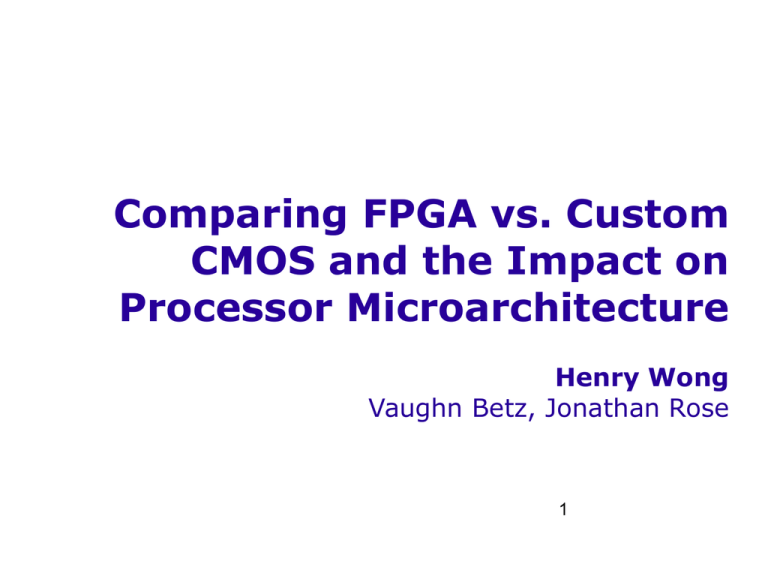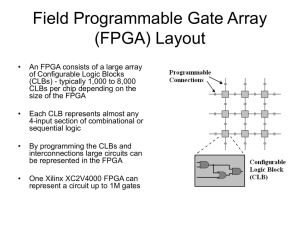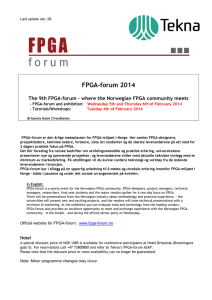Comparing FPGA vs. Custom CMOS and the Impact
advertisement

Comparing FPGA vs. Custom CMOS and the Impact on Processor Microarchitecture Henry Wong Vaughn Betz, Jonathan Rose 1 Processor Microarchitecture Microarchitecture: How to arrange circuits to make a processor Depends on how efficient the circuits are Which depends on the substrate Custom CMOS Standard Cell FPGA 2 Goals Make good microarchitecture design choices for bigger and faster FPGA soft processors Much existing literature on processor design for custom CMOS implementation Comparisons of overall area/delay between substrates exist But relative building block costs vary up to two orders of magnitude on FPGA vs. Custom CMOS This work: compares building blocks and infer microarchitectural conclusions 3 Also applicable to circuits other than processors What we're measuring 1. Focus on processors as the complete circuit 2. Compare building block circuits that are often used in processors 3. FPGA vs. Custom: Synthesize RTL for FGPA SRAM, CAM, Multiplier, Adder, … Infer how existing microarchitectures should be modified for FPGA 4 Methodology FPGA circuits synthesized through Quartus II 10.0 Largest, fast speed grade, 65 nm Stratix III (3LS340) Area calculated from FPGA tile areas A few results are from literature Custom CMOS design examples found in literature High-performance circuit design and 5 layout are difficult and time consuming Metrics Area Still a key design constraint on FPGAs Delay Power or energy: Not considered here Data not often published and testing conditions not standard. FPGA users mostly spared responsibility for not melting the chip. 6 1. Processor Core Comparison Complete circuit serves as a reference point for sub-circuit measurements later 7 Processor Core Comparison SPARC T1 and T2, Intel Atom and Nehalem Compare CMOS to FPGA implementations Compare just one core, excludes large caches FPGA implementation used RTL optimized from the custom CMOS implementation 8 Atom and Nehalem results cited from Processor Cores: Area Custom Area (mm2) FPGA Area (mm2) Area Ratio SPARC T1 6.0 100 17 SPARC T2 11.7 294 25 Intel Atom 12.8 350 27 Intel Nehalem 51 1240 24 Geometric Mean Area ratio: FPGA/Custom area 17-27x (Geomean 23x) 23 9 Processor Cores: Speed Custom fmax FPGA (MHz) fmax (MHz) Speed Ratio SPARC T1 1800 79 23 SPARC T2 1600 88 18 Intel Atom >1300 50 26 Intel Nehalem 3000 0.52 - Geometric Mean Speed ratio: Custom/FPGA fmax 18-26x (Geomean 22x) 22 10 2. Building Block Comparisons Compare area and delay Will go through one example on SRAMs 11 Single-Port SRAM Custom: A few design examples from literature and data from the CACTI area and delay models FPGA: Four ways to build memory on Stratix III M144K (2k x 72-bit) M9K (256 x 36-bit) MLAB (32 x 20-bit) Registers and muxes Used (n x 32-bit) memories in this section 12 Single-Port SRAM Density 2-5x Hard SRAM blocks save area 13 Single-port density ratio: 2-5x (compare to 23x) Partly due to FPGA's dual-ported memory blocks Single-Port SRAM Fmax 7-10x SRAMs 7-10x ratio for < 256 kbit (compare to 14 22x) Multiported SRAM Density (2kb) 143x: 7x: Replicate Registers RAM andtwice muxes forfor 2r1w 4r2w 23x: Replicate RAM 8x for 4r2w Density ratio: 7x for 2r1w, more write ports 15 worse Summary: Building Blocks Lower ratios are better for FPGA Processor Cores Area Ratio Delay Ratio 17 - 27 18 - 26 SRAM single port (1rw) 2 - 5 7 - 10 SRAM 4r2w LVT 4r2w 143 23 13 10 CAM 100 - 210 14 Multiplexer >100 20 - 75 Multiplier 4.5 - 7.0 17 - 22 Adder 4.5 - 7.0 15 - 20 Pipeline Latch 12 - 19 Routing 9 - 20 Off-Chip Memory 1.3 - 216 Building Blocks Area dominates the differences between block types Multiplexers are slow SRAM bits are cheap Multiported memories are expensive CAMs and muxes are expensive Hard adders/multipliers save area, but aren't fast Pipeline latches slightly faster These costs affect microarchitecture choices... 17 3. Processor Microarchitecture Multiported RAM CAM Multiplexers 18 SRAM Ports: Clustered RF Choose architecture to minimize register file ports Clustered register files: One write port per cluster 19 Scheduler CAM: Intel P6 P6 to Nehalem Values stored in three places RS is a CAM that stores values 20 Scheduler CAM: AMD K7 AMD K7/K8/K10 Values stored in three places RS is a CAM that stores values 21 Physical Register File MIPS R10000, Intel P4, Sandy Bridge, AMD Bobcat Values stored in one place Scheduler CAM stores no operands 22 PRF: Fewer multiported RAMs and smaller CAM Reducing Bypass Muxes Two sets of bypass muxes per operation Multiple issue makes bypass muxes even bigger 23 Fusing Operations Chaining dependent operations: 3 muxes/2 ops Fused multiply-add works especially well because incremental cost of second operation is small Point-to-point saves one bypass mux 24 Summary Need to measure cost of building block circuits to guide microarchitecture design choices Relative area costs span 2 orders of magnitude Microarchitecture choices should reflect costs Examples: Reduce RAM port count, CAM size, and multiplexers; Take advantage of cheaper ALUs Use clustered physical register file, (no reservation stations); Explore fusing 25 dependent operations together Future Work Use these results to guide the design of a larger and higher-performance soft processor Use existing microarchitecture literature as guidance, and adapt for FPGA substrate 26 Thank You! 27











